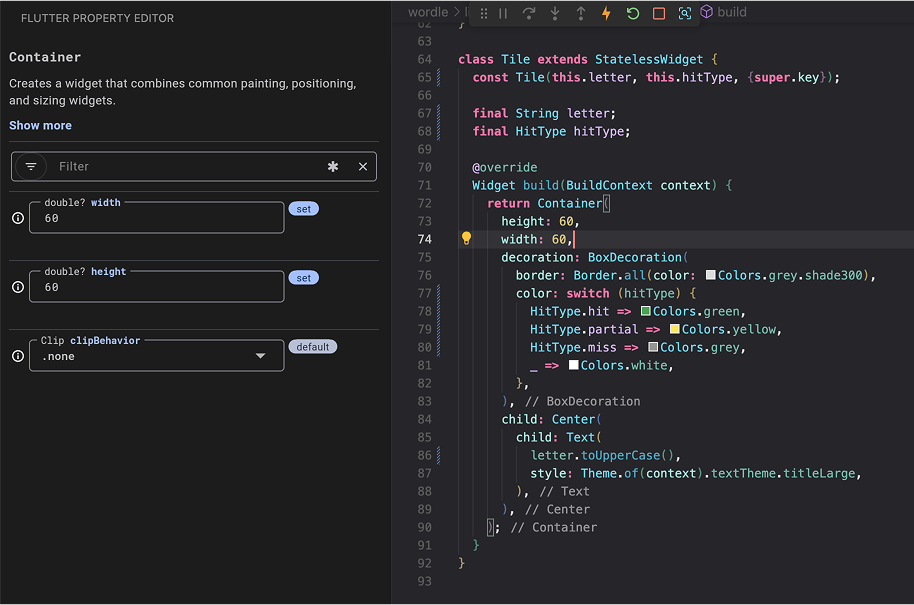DevTools
As your Flutter app grows in complexity, it becomes more important to understand how each of the widgets properties affect the UI. Dart's DevTools assists you with two particularly useful features: the widget inspector and the property editor.
First, launch DevTools by running the following commands while your app is running in debug mode:
$ flutter pub global activate devtools # You only need to run this once
$ devtoolsThe widget inspector
#The widget inspector allows you to visualize and explore your widget tree. It helps you understand the layout of your UI and identifies which widgets are responsible for different parts of the screen. Running against the app you've built so far, the inspector looks like this:

Consider the GamePage widget you created in this section:
class GamePage extends StatelessWidget {
const GamePage({super.key});
final Game _game = Game();
@override
Widget build(BuildContext context) {
return Padding(
padding: const EdgeInsets.all(8.0),
child: Column(
spacing: 5.0,
children: [
for (var guess in _game.guesses)
Row(
spacing: 5.0,
children: [
for (var letter in guess) Tile(letter, )
]
),
],
),
);
}
}And how it's used in MainApp:
class MainApp extends StatelessWidget {
const MainApp({super.key});
@override
Widget build(BuildContext context) {
return MaterialApp(
home: Scaffold(
body: Center(child: GamePage()),
),
);
}
}In the widget inspector, you should see a tree of exactly the same widgets that are in your code: MaterialApp as the root, with Scaffold as its home and an AppBar as its appBar, and so on down the entire tree to the Row widgets with Tile children. You can select any widget in the tree to see its properties and even jump to its source code in your IDE.
Debugging layout issues
#The widget inspector is perhaps most useful for debugging layout issues.
In certain situations, a widget's constraints are unbounded, or infinite. This means that either the maximum width or the maximum height is set to double.infinity. A widget that tries to be as big as possible won't function usefully when given an unbounded constraint and, in debug mode, throws an exception.
The most common case where a render box ends up with an unbounded constraint is within a flex box widget (Row or Column), and within a scrollable region (such as ListView and other ScrollView subclasses). ListView, for example, tries to expand to fit the space available in its cross-direction (perhaps it's a vertically-scrolling block and tries to be as wide as its parent). If you nest a vertically scrolling ListView inside a horizontally scrolling ListView, the inner list tries to be as wide as possible, which is infinitely wide, since the outer one is scrollable in that direction.
Perhaps the most common error you'll run into while building a Flutter application is due to incorrectly using layout widgets, and is referred to as the "unbounded constraints" error.
Watch the following video to get an understanding of how to spot and resolve this issue.
Watch on YouTube in a new tab: "Decoding Flutter: Unbounded height and width"
The property editor
#When you select a widget in the widget inspector, the property editor displays all the properties of that selected widget. This is a powerful tool for understanding why a widget looks the way it does and for experimenting with property value changes in real-time.

Look at the Tile widget's build method from earlier:
class Tile extends StatelessWidget {
const Tile(required this.letter, required hitType, {super.key});
final String letter;
final HitType hitType;
@override
Widget build(BuildContext context) {
return Container(
width: 60,
height: 60,
decoration: BoxDecoration(
border: Border.all(color: Colors.grey.shade300),
color: switch (hitType) {
HitType.hit => Colors.green,
HitType.partial => Colors.yellow,
HitType.miss => Colors.grey,
_ => Colors.white,
},
),
);
}
}If you select a Tile widget in the Widget Inspector, the Property Editor would show you its width (60), height (60), and the decoration property. You could then expand the BoxDecoration to see the border and color properties.
For many properties, you can even modify their values directly within the property editor. For example, to quickly test how a different width or height would look for your Container in the Tile widget, change the numerical value in the Property Editor and see the update instantly on your running app without needing to recompile or even hot reload. This allows for rapid iteration on UI design.
Unless stated otherwise, the documentation on this site reflects the latest stable version of Flutter. Page last updated on 2025-06-06. View source or report an issue.